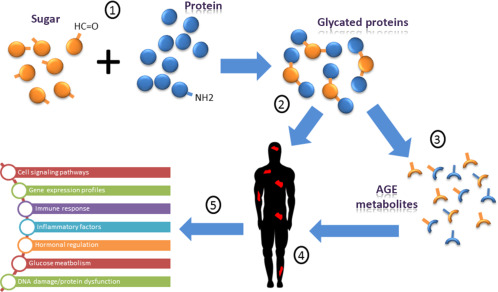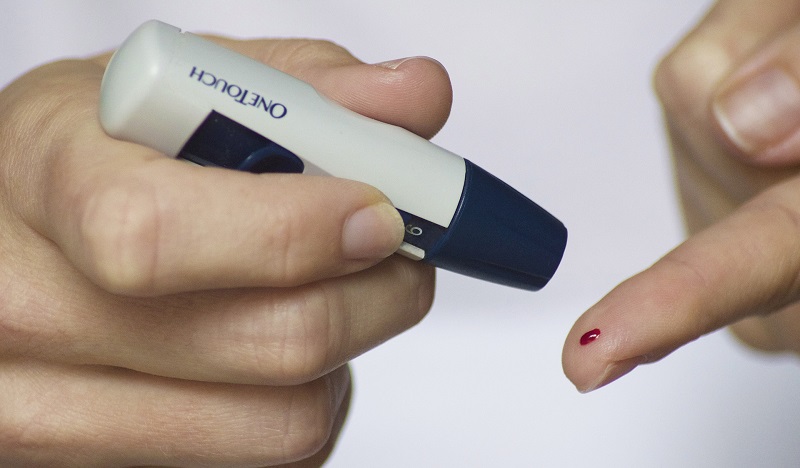AGEs DamAGE Our Bodies. (Advanced glycation end-products)
Summary: AGEs (advanced glycation end-products) are in the spotlight again as geroscientists implicate this toxic waste of our bodies in a multitude of health conditions, including inflammaging, cancer, and diabetes. Some scientists go as far as to link AGEs to an increase in the chronic inflammation which leads to heart attacks. [This article first appeared on the website LongevityFacts.com. Author: Brady Hartman. ]
Executive Summary
Are advanced glycation end-products (AGEs) a villain that causes chronic diseases or are they merely an innocent bystander?
Anti-aging scientists are coming to the growing conclusion that AGEs play a significant role in inflammation and the chronic diseases of aging, such as diabetes, heart disease, and many others. Furthermore, some geroscientists suspect that AGEs significantly contribute to cancer.
In an earlier review that links AGEs with cancer, David P. Turner, a researcher with the Department of Pathology & Laboratory Medicine at the Medical University of South Carolina in Charleston (MUSC) sums it up by saying,
“Advanced glycation end-products (AGEs) are reactive metabolites produced as a by-product of sugar metabolism. Failure to remove these highly reactive metabolites can lead to protein damage, aberrant cell signaling, increased stress responses, and decreased genetic fidelity.”
Earlier this year, Turner updated his research on the link between advanced glycation end-products and cancer, as you will read later on.
Turner and other researchers are adding to the growing body of evidence against AGEs. Geroscientists are sure that the steps we take to reduce AGEs are incredibly good for our health. That is, having low blood sugar, low cholesterol levels and eating less processed foods are sure-fire ways to lengthen our lives and coincidently also reduce advanced glycation end-products.
Bottom Line: AGEs are bad for our health. However, scientists don’t know the exact extent. There is hope, however. Scientists have come up with ways to prevent the build-up of advanced glycation end-products.
AGEs DamAGE Our Bodies
What Scientists Know About AGEs
Turner is not the only geroscientist accusing AGEs of misconduct. Other researchers already know that advanced glycation end products naturally build up in our bodies as we grow older, although the things we eat can also increase their levels. Geroscientists show that AGEs raise the level of cellular damage, which in turn increases the levels of chronic inflammation. Aging is accompanied by a chronic low-level inflammation called inflammaging that affects nearly every cell in the body. Moreover, as you will read later on, they have the evidence to back it up. As well, leading geroscientists, such as Carlos Lopez-Otin, the author of the landmark report The Hallmarks of Aging, believe that the chronic inflammation significantly contributes to the progression of a slew of chronic diseases.
Strong Suspicions About AGEs
Many researchers have indicted AGEs as a major villain in chronic diseases with an inflammatory component such as asthma, atherosclerosis, arthritis, cancer, heart disease, kidney disease, blindness, and neuropathic pain. While geroscientists are confident that advanced glycation end products increase levels of chronic inflammation, and contribute to a handful of chronic diseases, they are not quite sure how large of a role AGEs play in these conditions.
Bad habits such as a high-fat, high-sugar diet simultaneously lead to both increased incidences of these chronic diseases as well as increased levels of advanced glycation end products. Whenever any one of these chronic diseases strikes, large numbers of AGEs are always at the scene of the crime.
Bottom Line: There is a growing consensus that AGEs are responsible for vandalism to our bodies, increase inflammaging and stoke the fires of chronic diseases.

It’s So Easy to Get Glycated These Days
AGEs are a diverse array of compounds produced in the body through a variety of chemical reactions. In a process called glycation, AGEs form when sugars combine with proteins or fats. When sugar latches on to one of these molecules, it creates what is known as an advanced glycation end-product.
For example, consider a lab test called the hemoglobin A1c test. If you have ever been tested for diabetes or prediabetes, then you are probably aware of the A1c test. This common diagnostic for diabetes measures the blood levels of an advanced glycation end-product called glycated hemoglobin. As an aside, if you are over 45 or overweight, the ADA says you ought to get tested for prediabetes and diabetes.
The A1C test also abbreviated HbA1c, and HbgA1c is a blood test that measures a person’s average blood sugar levels over the past three months. To keep us even more confused, doctors use a multitude of names, such as glycohemoglobin, glycated hemoglobin, and glycosylated hemoglobin to all refer to the same compound.
Whatever you want to call it, glycated hemoglobin is a common AGE in your bloodstream. Glycosylated hemoglobin forms when sugar chemically attaches to hemoglobin. The more sugar in your blood, the more glycated hemoglobin, and the higher your A1c reading. The higher your A1c level, the more likely your doctor will diagnose you with prediabetes or diabetes.
What Increases Advanced Glycation End-Products?
AGEs are more likely to form when blood sugar is elevated, which explains the higher levels of advanced glycation end-products in people with poorly controlled type 2 diabetes. People also consume advanced glycation end-products, mostly from cooked or processed foods, and absorb them from tobacco smoke. The body can eliminate AGEs using enzymes and expel them via the kidneys, but the advanced glycation end-products formed in the body are more likely to accumulate.

Who Discovered AGEs?
In 1912 a French scientist named Louis-Camille Maillard discovered how AGEs form in food. Maillard was the first to explain the chemical reaction – subsequently named the Maillard reaction – results from the browning of certain foods when cooked, such as bread crust and meat. Scientists have researched AGEs for the past 20 years, and are increasingly focused on food sources of these compounds.
Why Do Advanced Glycation End-Products Form?
Advanced glycation end-products build up naturally in the body as we grow older. While high blood sugar is the main culprit, high cholesterol also accelerates the build of AGEs. We get advanced glycation end-products through our diet, as well. Components of certain foods called dietary advanced glycation end-products (dAGEs) contribute to the levels of AGEs in our body and also increase the risk of diseases such as kidney disease and atherosclerosis. Scientists do not fully understand how well the AGEs we consume from foods are absorbed by the gut, nor whether vitamins and other nutrients influence their effects on the body.
Advanced Glycation End-Products and Diabetes
Scientists strongly suspect that advanced glycation end-products are involved in the progression of diabetes and the complications of the disease.
In diabetics, uncontrolled blood sugar leads to higher risks of all kinds of complications, including heart disease, stroke, kidney disease, amputations, and blindness. Scientists have not conclusively fingered AGEs as the culprit behind these complications, but in my book, they are the number one suspect.
Research on Advanced Glycation End-Products
The strongest research evidence studies the effects of AGEs in humans. However, a research experiment in which scientists fed a diet high in AGEs to mice is very telling.

Dietary AGEs Induce Diabetes in Mice
While human studies are far more reliable, mouse studies can add insight because researchers can do things to mice that would be unethical to humans. Furthermore, mice develop diseases much faster than humans, who take decades to develop chronic disease. For example, in a study published in Diabetes, the journal of the American Diabetes Association, a team of researchers at New York’s Mount Sinai Medical Center (MSMC) fed lab mice a diet high in AGEs and compared them to normally fed controls. The MSMC researchers found that the mice on a diet high in dietary AGEs were significantly more like to develop diabetes when compared to controls. The researchers divided the mice into three groups: a) a high-fat diet high in AGEs b) high-fat diet low in AGEs c) normally fed control mice.
After waiting for six months, the human equivalent of 34 years, 75% of the mice on the high AGE diet developed diabetes, while none of the mice on the low AGE diet developed the condition. The mice on the two high-fat diets gained similar amounts of body weight.
Bottom Line: Researchers showed that, at least for mice, fat is not to blame for causing diabetes, instead of advanced glycation end-products are responsible.

Human Study On Advanced Glycation End-Products
In a study published in the journal Diabetologia in 2016, researchers at New York’s Mount Sinai Medical Center (MSMC) analyzed the role of AGEs and the risk of type 2 diabetes. The MSMC researchers randomized 61 obese people with metabolic syndrome into two groups: Half ate a diet low in AGEs while the other half ate a standard American diet that was high in advanced glycation end-products. The participants on the low-AGE diet were told to avoid grilling, baking, or frying food to reduce consumption of advanced glycation end-products. After one year, the group on the low AGE diet had lower blood levels of advanced glycation end-products, a reduction in insulin resistance, a decrease in markers of inflammation and oxidative stress, and a small amount of weight loss to boot.
AGEs and Insulin Sensitivity in Humans
Similarly, in a small Australian study published in the American Journal of Clinical Nutrition in 2016, healthy overweight people were put on a low AGE diet low for two weeks. At the end of the study period, the participants on the diet low in AGEs had improved insulin sensitivity compared to those on a diet high in advanced glycation end-products.

Do AGEs Cause Diabetes?
The levels of advanced glycation end-products in our bodies increase as we age, and the rates of diabetes rise correspondingly. In fact, by the age of 65, two-thirds of all American adults have either diabetes or prediabetes. Correlation does not imply causation, but it sure is a hint. The correlation combined with the animal and human research studies strongly argue that AGEs make us significantly more susceptible to prediabetes and type 2 diabetes.
Prediabetes is the condition where a person has high blood sugar, but not high enough to be considered diabetes. The World Health Organization (WHO) estimates that prediabetes kills one and half times as many people as diabetes because it is far more prevalent and far more undetected than diabetes.
This is a great tragedy due to that fact that prediabetes can be treated by a diet and exercise, or medication. Coincidentally, the drug metformin, the same medication that doctors use to treat prediabetes and diabetes is also a lifespan-extension drug.
Cardiovascular Disease of the AGEs
Scientists strongly suspect that AGEs stoke the disease of atherosclerosis. In turn, atherosclerosis, also called hardening of the arteries, leads to cardiovascular disease and heart attacks. An earlier report links inflammation to heart disease.
Cancer of the AGEs
Researcher David Turner has sharpened his pencil as of late. This year (2017) Turner published an updated review of the role of AGEs in cancer in the journal Advances in Cancer Research. In this special compendium on cancer, which includes the works of many other researchers, Turner makes a stronger case for a role of AGEs in cancer, saying
“Due to their links with lifestyle and the activation of disease-associated pathways, AGEs may represent both a biological consequence and a bio-behavioral indicator of poor lifestyle which may be targeted within specific populations to reduce disparities in cancer incidence and mortality.”
AGEs in Alzheimer’s Disease
As we grow older, AGEs accumulate in the brain and other tissues. Researchers have implicated advanced glycation end-products in cultured neuronal toxicity as well as beta-amyloid aggregation in Alzheimer’s disease.
Cleaning out Advanced Glycation End-Products
Medical science has yet to invent a magic pill or potion that cleans a significant portion of AGEs from the body. Prevention is your best bet, and keeping your blood sugar low is a proven way to prevent a ton of chronic diseases, including cancer, heart disease, and diabetes.
For example, consider glucosepane, by far the most common AGE in human tissue. Glucosepane forms cross-links in the collagen of our arteries and joints, causing them to become stiffer. As we age, the level of glucosepane in our collagen increases, leading to arteriosclerosis and joint stiffening. Due to decades of elevated blood sugar levels, this effect is accentuated in people with diabetes.
To reverse aging, geroscientists are searching for compounds that reverse cross-linking and return our joints and arteries to their youthful, supple state. Researchers that they had found such a substance with the discovery of a compound called alagebrium (ALT-711.)
ALT-711 produced seemingly miraculous effects in aging and diabetic lab animals and substantially lowered their blood pressure. However, alagebrium was a disappointment when tested on humans, producing only minor effects.
If we are to reverse aging, research on glucosepane is sorely lacking and sorely needed. Reason at fightaging.org has a good description of the subject, as well as a recent update on the efforts of researchers developing monoclonal antibodies that attack glucosepane.
Bottom Line: There are no adequate cleaning products to get rid of advanced glycation end-products.

Reducing AGEs in Food
AGEs occur naturally in many foods, especially animal-derived products, such as meats that are rich in fat and protein. The level of advanced glycation end-products in food depends on how you cook or prepare it. High temperatures produce more advanced glycation end-products, but AGEs can also be found in aged cheeses (no pun intended). As well, specific processes used by food manufacturers to add flavor or color to their products also boost advanced glycation end-products.
Compared to low-heat methods, more advanced glycation end-products form when cook meat with dry-heat methods, including roasting, grilling, frying, or baking. All of these methods cook at relatively high temperatures and for longer times than the low-heat methods. Low-heat methods produce the lowest levels of AGEs and include boiling, steaming, poaching, or stewing. As well, low-heat methods retain food moisture. Microwaving produces fewer advanced glycation end-products because of its relatively short cooking times. The source of animal protein also affects the generation of AGEs, with beef having the most, and fish the least. The fat content in meat tends to contain more advanced glycation end-products. Marinating meat with acidic preparations such as lemon juice and vinegar inhibits advanced glycation end-product formation.
On the flip side, fruits and vegetables are not only healthy, but they are also low in AGEs, even when cooked. As well, many grains are lower in advanced glycation end-products. However, grain products such as cookies, crackers, and chips are higher in AGEs because they are processed with dry heat methods and loaded with additional fats and sugars. Despite this, when compared to meat, processed grain products such as potato chips have a lower content of advanced glycation end-products. Potatoes are a healthy vegetable, unfortunately, frying them boosts their levels of AGEs.
Bottom Line
AGEs are bad for our health. However, scientists do not know the precise extent. Geroscientists need to perform more research to fully understand the health effects of advanced glycation end-products, including both those produced by the body and those we consume from foods. Meanwhile, what we know about AGEs does not change our thinking about healthy eating. Recent research reports have given us good reasons to limit fatty meats, especially those cooked with high heat, a process that produces carcinogens such as heterocyclic amines. As well, doctors advise us to limit fried or highly processed foods such as French fries and chips. Moreover, so-called heart-healthy eating patterns, such as the Mediterranean diet, are low in advanced glycation end-products. Also, low AGEs diets are those low in processed foods, meat and fast foods and rich in fruits and vegetables, legumes, whole grains, fish, and low-fat dairy.
Show Us Some Love
- One click helps us spread the word – Share this post on your social media account and help your friends. It only takes one click on any of the social media links on this page.
- Follow us on social media – For weekly articles, follow us on Facebook | Reddit | Google+.
- Sign up for our email list – We use your email to notify you of new articles. We don’t spam and we don’t share your email address. Cancel at any time.
- Tell us what you think – We want to hear what you think. Scroll down to leave your comments below.
References
Turner, David P. “Advanced Glycation End-Products: A Biological Consequence of Lifestyle Contributing to Cancer Disparity.” Cancer Research 75.10 (2015): 1925–1929. PMC. Web. 17 Oct. 2017. Link to Article.
Carlos López-Otín, et al. “The Hallmarks of Aging.” Cell, Volume 153, Issue 6, 1194 – 1217 (2013). Available Online.
Oana Sandu, Keying Song, Weijing Cai, Feng Zheng, Jaime Uribarri, Helen Vlassara. “Insulin Resistance and Type 2 Diabetes in High-Fat–Fed Mice Are Linked to High Glycotoxin Intake.” Diabetes Aug 2005, 54 (8) 2314-2319; DOI: 10.2337/diabetes.54.8.2314. Link to Article.
D.P. Turner, Chapter One – The Role of Advanced Glycation End-Products in Cancer Disparity, Editor(s): Marvella E. Ford, Dennis K. Watson, In Advances in Cancer Research, Academic Press, Volume 133, 2017, Pages 1-22, ISSN 0065-230X, ISBN 9780128098783, https://doi.org/10.1016/bs.acr.2016.08.001. Alternate Link.
Disclaimer
Diagnosis, Treatment, and Advice: This article is intended for educational and informational purposes only and is not a substitute for professional medical advice. The information and opinions provided herein should not be used during any medical emergency or for the diagnosis or treatment of any medical condition. Experimental therapies carry a much higher risk than FDA-approved ones. Consult a licensed and qualified physician for the diagnosis and treatment of any and all medical conditions. Call 911, or an equivalent emergency hotline number, for all medical emergencies. As well, consult a licensed physician before changing your diet, supplement or exercise programs. Photos, Endorsements, & External Links: This article is not intended to endorse organization, companies, or their products. Links to external websites, mention or depiction of company names or brands, are intended for illustration only and do not constitute endorsements.

Ha, I’ve been talking about AGE products for 3+ years!
https://michaellustgarten.wordpress.com/2014/07/25/advanced-glycation-end-products-theres-more-to-health-than-counting-calories-protein-fat-and-carbs/
Very interesting